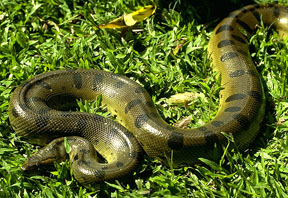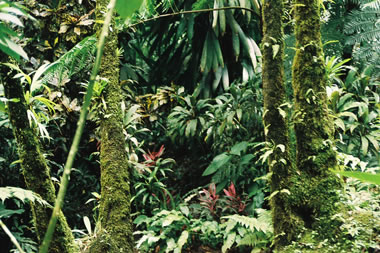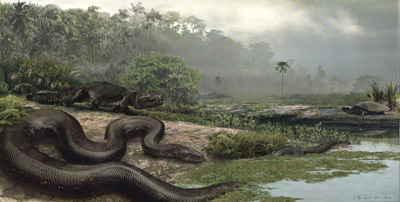This illustration shows the size of the fossil snake.
Click on image for full size
Courtesy of Jason Bourque, University of Florida
Prehistoric Fossil Snake is Largest on Record
News story originally written on February 4, 2009
Scientists discovered the fossils of a gigantic snake. It lived in South America 60 million years ago. It was longer than a school bus and weighed 1140 kilograms (2500 pounds). This snake was a constrictor, which means it would wrap its huge body around its prey before eating.
Scientists discovered the fossils of the snake in a coal mine in northern Colombia. They also looked for clues in the rocks to learn what the environment where the snake lived was like. They discovered that it was a tropical rainforest.
The tropical rainforests that were in South America 60 million years ago were very different than the rainforests that are there today. It was hotter then. Plus, the reptiles that lived there, like the snake, were much larger.
Places with warmer temperatures tend to be home for larger cold-blooded animals. This means that when Earth’s climate is warmer, the cold-blooded animals are larger. The scientists say that this fossil snake’s size means that the temperature was five degrees Celsius warmer than today’s tropical rainforests.
Last modified March 27, 2009 by Lisa Gardiner.
You might also be interested in:

The tropical rain forests of the world are full of reptiles. There are many snakes in the jungle. The anaconda is one snake family. They can grow to 30 feet long. Anacondas wrap around their prey and
...more
Have you ever been to a rainforest? Rainforests have very different trees than the ones you might climb in your yard. Thousands of species of plants and animals live in the rain forests of the world. But
...more
How do you know to pack your bathing suit and sunhat for a trip to a tropical island or pack warm sweaters and coats for a trip to Alaska? If you know a little about regional climates, then you know what
...more
Scientists have learned that Mount Hood, Oregon's tallest mountain, has erupted in the past due to the mixing of two different types of magma. Adam Kent, a geologist at Oregon State University, says this
...more
The Earth's mantle is a rocky, solid shell that is between the Earth's crust and the outer core. The mantle is made up of many different reservoirs that have different chemical compositions. Scientists
...more
Some faults look strong and like they wouldn’t cause an earthquake. But it turns out that they can slip and slide like weak faults causing earthquakes. Scientists have been looking at one of these faults
...more
The sun goes through cycles that last approximately 11 years. These solar cycle include phases with more magnetic activity, sunspots, and solar flares. They also include phases with less activity. The
...more















